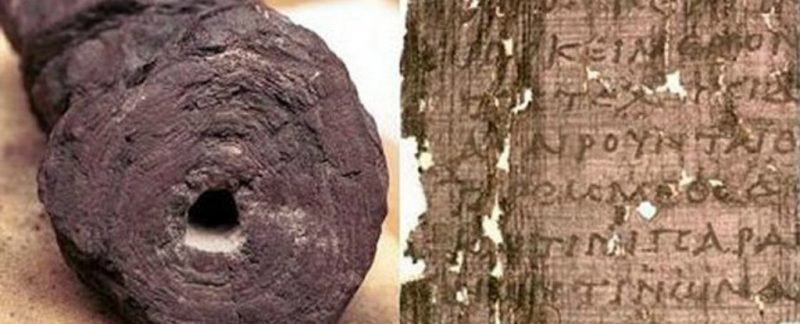Pioneering X-ray imaging has allowed scientists to begin to unravel the mysteries of the Herculaneum “library” – the scrolls that were preserved by the eruption of Mt. Vesuvius in 79 AD. They were discovered among the ruins of a villa in the unfortunate town of Herculaneum. For years, no one has been able to figure out what the scrolls contained because the papyri had been charred into fragile blocks during the eruption.
The X-rays utilized by scientists allow the scrolls to be virtually unrolled, so that scraps of Greek text can be deciphered. This discovery of metal ink reveals the level of sophistication of the technology of ancient Rome and Greece. Prior to this discovery, it was believed that metal ink had not been widely used until about 420 AD.
The scrolls are being examined at the European Synchrotron Radiation Facility (ESRF) by various researchers, one of whom is Dr. Daniel Delattre, a papyrologist affiliated with the Institute for Research and Historic Texts at the French National Centre for Scientific Research.
Commenting on the discovery, Dr. Delattre said: “For nearly 2,000 years, we thought we knew everything, or almost everything, about the composition of antique ink used to write on papyrus.” Delattre and his colleagues examined two fragments of the papyri from Herculaneum, leading them to determine that the ink contained high levels of lead.
This suggested that the metal had been deliberately added to create ink. “The highly specialized studies carried out at the European Synchrotron show us that we must be wary of our ideas and that the ink also contained metal, notably lead in sizeable quantities.” Dr. Delattre added.
Many different scrolls, some intact and others not, have been recovered from Herculaneum, specifically from the Villa of the Papyri, as it is known. One of the most famous writers whose works have been recovered is Philodemus of Gadara. Born around 35 BC, Philodemus was an Epicurean philosopher and poet.
Epicurian philosophy followed the teachings of Epicurus (341 to 270 BC), which claim that the purpose of life was to enjoy a happy, pain-free existence. It encouraged people to surround themselves with friends and to live self-sufficiently. Philodemus himself studied in Athens before moving to Rome and, finally, to Herculaneum. Before the eruption, Herculaneum had been a bustling Roman city. Now, its ruins are a major tourist attraction.
The Herculaneum papyri were originally discovered between the years 1752 and 1754 by workmen who had been hired by the Bourbon royal family. They were digging in the remains of the ancient villa. The excavation of these scrolls continues today.
06
For the most part, the scrolls contain a number of philosophical texts, as well as considerable amount of texts done by Philodemus of Gadara. Over the years, the texts carbonized into fragile cubes due to the lack of oxygen in the room where they were kept. They were thought to have survived because although the heat produced by the eruption of Mt. Vesuvius was intense, it was fairly brief.
The fact that they carbonized, however, means that they cannot be unrolled without suffering severe damage. Some scrolls had unrolled by themselves during the process of carbonization, and those could be read by experts, but the other scrolls remained a mystery for decades.
That is, until last year. Dr. Delattre used a technique known as 3D Phase Contrast Tomography. This allowed them, through the powerful X-ray imaging, to recreate the scrolls digitally, meaning some of the text could be revealed. After that, the scientists combined several techniques using the X-ray and were able to analyze the ink that was used on the two fragments of papyrus from the Herculaneum library. The amount of lead found in the ink was too high to have been caused by contamination from water or from a copper (or bronze) inkpot.
Phrase Contrast Tomography reads the subtle differences in the way radiation pass through different materials, such as papyrus and ink. So far, several letters on one scroll have become visible; the sequence of the letters reads “PIPTOIE”. Researchers believe that it may read “would fall”.
Of course, some letters are more distinct than others. The shapes of some letters makes them easily confused with others. That being said, the marks themselves are distinct. Papyrus fibers run vertically and horizontally, which make the rounded or oblique letter shapes obvious. These discoveries open up the possibility of trying this method on the other, more damaged scrolls.
These two fragments are thought to be one of the earliest examples of metal ink in existence; there are, however, some cases where metal-based ink had been used to compose secret messages in the second century BC.
The main author of the study, Emmanuel Brun, has written about the findings in the Proceedings of the National Academy of Sciences. “This discovery is a new step in the exciting adventure of studying the papyrus of Herculaneum.” Brun said, “The different phases of the present study on the ink will allow us to optimize the next experiments on the reading of the invisible text within papyri.”
Lead image: Brian Donovan, University of Auckland/Herculaneum Conservation Project
